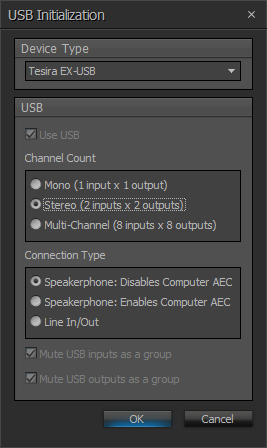USB Network Considerations
The TesiraFORTÉ USB port is a USB 2.0 port that complies with the USB Audio Class 1.0 (UAC1) specification and can be used to connect to a PC or any device that provides UAC1 drivers. Most modern computer operating systems include generic USB Audio drivers, including Windows, Mac OS X and Unix-based operating systems.
The Tesira EX-UBT and EX-USB USB port complies with both UAC1 and USB Audio Class 2.0 (UAC2) by providing a stereo speakerphone (UAC1) or 8 input x 8 output Line In/Out only (UAC2).
To use the USB Initialization dialog to configure a TesiraFORTÉ device, plug it into a PC/Mac and have the device show up with the channels that were specified on the USB blocks within Tesira design software.
The USB interface specifically supports usage with the following:
- Soft Codec support using Skype or Microsoft Lync client software - Via the Speakerphone option in the initialization Dialog
- ForTheRecord court recording software - Via the Line In/Out option in the initialization Dialog
Supported channel configurations
TesiraFORTÉ:
-
Audio stream rates are defined as either 24-bit/48kHz (up to 6 total channels I/O) or 16-bit/48kHz (up to 8 total channels I/O). The maximum bit rate is dependent on the total number of input and output channels used by the device.
EX-UBT:
-
All Tesira EX-UBT USB audio channels will operate in fixed 24/16-bit/48kHz.
NOTE: "USB host" refers to the USB on the PC.
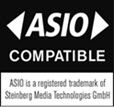
Biamp USB Driver
To accommodate the need for high channel count USB audio, users may download and install the Biamp USB driver, available here:
https://www.biamp.com/tesirausbdriver
The driver supports both the TesiraFORTÉ and EX-UBT / EX-USB.
Note the following with Windows:
- Windows 7 does not have native support for UAC2 and Audio Stream Input/Output (ASIO)*
- Windows 10 does not have native support for ASIO, although Windows 10 version 1703 does include native support for UAC2.
*ASIO is a sound card driver protocol for digital audio. It provides a low-latency, high-fidelity interface between software applications and a computer sound card.
The following channel and bit depth are supported if using the Biamp driver:
TesiraFORTÉ
| In | Out | Bit Depth |
| 2 | 6 | 16 |
| 4 | 0 | 16 |
| 4 | 0 | 24 |
| 4 | 4 | 16 |
| 8 | 0 | 16 |
| 0 | 4 | 16 |
| 0 | 4 | 24 |
| 0 | 6 | 16 |
| 0 | 6 | 24 |
| 0 | 8 | 16 |
Tesira EX-UBT / EX-USB
| In | Out | Bit Depth |
| 8 | 8 |
24 |
Channel and Bit Depths
The following channel and bit Depths are supported without the Bimap USB driver. The Sampling Rate is fixed at 48kHz.
TesiraFORTÉ
-
Speakerphone with AEC and without AEC
| In | Out | Bit Depth |
| 1 | 1 |
16 |
-
Audio In and Out
| In | Out | Bit Depth |
| 2 | 2 | 24 |
| 2 | 0 | 24 |
| 0 | 2 | 24 |
| 2 | 6 | 16 |
| 0 | 6 | 24 |
| 4 | 4 | 16 |
| 4 | 0 | 24 |
| 0 | 4 | 24 |
| 8 | 0 | 16 |
| 0 | 8 | 16 |
Tesira EX-UBT / EX-USB
-
Speakerphone with AEC and without AEC
| In | Out | Bit Depth |
| 1 | 1 |
24 |
| 2 | 2 |
24 |
-
Audio In and Out
| In | Out | Bit Depth |
| 2 | 2 |
24 |
Wiring

Connecting to a USB Host
If a TesiraFORTÉ or EX-UBT / EX-USB configuration has active USB blocks the first time the USB cable is connected, there may be some drivers and initialization required. See Biamp_USB_Driver for information on the suggested driver download. If a valid connection is in place, the Tesira device will appear as an audio device in the Host software.

In newer Windows operating systems, the connected USB device (EX-UBT in this case) will appear under settings in Bluetooth & other devices:
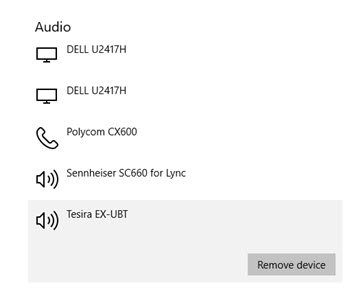
Tesira software has a USB option in the I/O block menu, available when a TesiraFORTÉ device is used in a configuration. There is also a USB option available Every time the USB option changes the Host operating system will update the drivers if necessary. For the EX-UBT / EX-USB, the USB block will be available when selecting that option from the initialization dialog.

The Input or output control dialog will give indication of the Connected and Streaming Status (this applies to the TesiraFORTÉ and EX-UBT / EX-USB).

TesiraFORTÉ USB Clocking and Synchronization
TesiraFORTÉ is an isochronous audio endpoint which can use its own internal clock (or AVB media clock) to synchronize data packets with the PC host (Asynchronous). Or it can adaptively synchronize to a host clock, making use of playback compensation (sample interpolation) to correct for clock mismatch (Adaptive).
A setting in the USB Input object’s DSP Properties, Enable Asynchronous (True/False) controls which method is used. True is the default value and should be appropriate for most uses. False selects the adaptive synchronization mode which would only be needed for USB hosts which must act as the master clock. Note that this synchronization method could result in audible distortion due to the sample interpolation used to maintain sync with the host.

Initialization options
The initialization dialog of the USB component object provides three options for how the connection is to be used.
| Note |
|
There is no AEC capability on the USB inputs, since these will generally be line level sources and/or far end sources. Microphones used in distance conferencing should be connected to AEC inputs. |
TesiraFORTÉ:

TesiraFORTÉ X

EX-UBT:
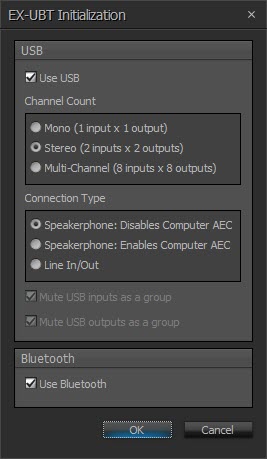
EX-USB:
Speakerphone
On the TesiraFORTÉ, two Speakerphone modes provide a single audio input and output stream for use with a soft codec application on a PC. The USB Input represents the incoming audio from the soft codec and the USB Output is used to send audio to the far side.
-
Speakerphone: Disables Computer AEC – In this mode, the TesiraFORTÉ will provide the Acoustic Echo Cancellation (AEC) function, and a control message is transmitted to the soft codec via the USB link telling it to disable its internal AEC. This would be appropriate for models that have built-in AEC (TesiraFORTÉ CI, TI, VI, VT, VT4).
-
Speakerphone : Enables Computer AEC – This mode is for situations where the soft codec will provide the Acoustic Echo Cancellation (AEC) function, which would be appropriate for models that do not have built-in AEC (TesiraFORTÉ AI).
TesiraFORTÉ

On the EX-UBT / EX-USB, the two speakerphone modes can be configured for a single audio input and output stream or stereo (two inputs and outputs) for use with a soft codec. The USB Input represents the incoming audio from the soft codec and the USB Output is used to send audio to the far side. The AEC settings mirror the TesiraFORTÉ as described above. Note that the EX-UBT/ EX-USB does not provide the AEC function; it is provided by the TesiraFORTÉ or Server/Server I/O device.
EX-UBT

When configured for speakerphone the soft codec being used will have the option to select the Tesira device as the audio input and output.
Note that the Tesira USB device transmits a request for the host PC/MAC/soft codec to disable AEC but it is up to the PC/MAC/soft codec to act upon that request.
TesiraFORTÉ Skype audio Options:

EX-UBT / EX-USB Skype for Business (S4B) Considerations:
Mute Synchronization
S4B recognizes Human Interface Device (HID) commands which are also implemented in Tesira. This implementation allows logic controls in the USB Input and Output blocks in Tesira software to perform the following functions:
- Muting the S4B microphone button changes the state (mutes) the USB output block in Tesira.
- Changing the state of the USB input block (mute) in the Tesira software will cause the S4B microphone button to mute.
- The audio playback mute button in Windows will cause the Tesira USB input block to change states (mute).
- Changing the state of the USB input block (mute) in the Tesira software will cause the Windows playback button to mute.
HID Controls
HID controls interact with the audio flow so the following states are achieved:
- Playback mute active state in the USB Input block means playback audio from the far end during an S4B call is muted.
- Record mute active state in the USB Output block means record audio going to the far end during an S4B call is muted.
Playback level can be adjusted in the computer operating system using the tray level control and will cause all the audio level of all playback channels in the USB Input block to scale. Note that balance controls from the USB host will not synchronize with the EX-UBT/USB USB input block.
The EX-UBT/USB may be selected from the "Select Primary Device" option in the S4B main interface:

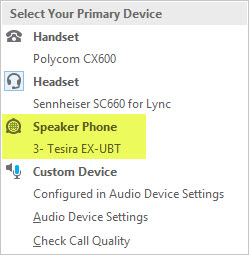
TesiraFORTÉ in Lync Audio Options:

Basic Layout
For an application using four microphones with no local Voice lift.
In the Layout below:
- the USB input and output blocks are configured to use Speakerphone.
- The Matrix mixer sends the USB input to the Room Output via the AEC reference block. Please note: as there is no local microphone reinforcement the AEC block has been placed 'inline'. The Green lines indicate the Soft Codec routing being used
- The Level Control is used as the master room audio - as the AEC Ref is inline, the AEC Ref and output signal level will track and AEC performance will remain optimized.
- Four Microphones are being used and the Matrix Mixer is sending the microphone signals to the USB output. The Purple lines indicate the Microphone routing being used.

Line In/Out
This mode provides up to 8 channels of audio. Input channels, Output channels or both can be selected, and the number of channels can be specified. Combinations of 2, 4 or 6 total USB channels can operate in 24-bit or 16-bit mode, selected by the Bit Depth control. Combinations of 8 total USB channels operate in 16-bit mode only. When connected and configured, the TesiraFORTÉ or EX-UBT / EX-USB device installs the chosen number of input and output channels in Windows, but they are not enabled by default. The channels can be enabled in the Windows Control Panel, and then selected as Record and Playback channels in the audio software application.
TesiraFORTÉ

EX-UBT / EX-USB

Notes on host operating system controls:
- In Multi-Channel 8x8 Line In/Out mode, changes to the USB host mute and record level controls will be ignored by the EX-UBT / EX-USB.
- Balance controls will not be synchronized between the USB input block and the USB host device when in speakerphone mode (only playback levels are).
Please note that due to the numerous possible versions of Windows operating systems in use and different versions 3rd-party applications, the exact configuration/interface of a user's system may not be provided in the setup examples that follow.
Channel settings
In Windows, right-click on the sound icon and select “Playback Devices”. This causes the Sound window to display, as shown. A Tesira device will present itself under Playback as “Line-#TesiraFORTE-Ready”. The EX-UBT / EX-USB will display as shown on the right:

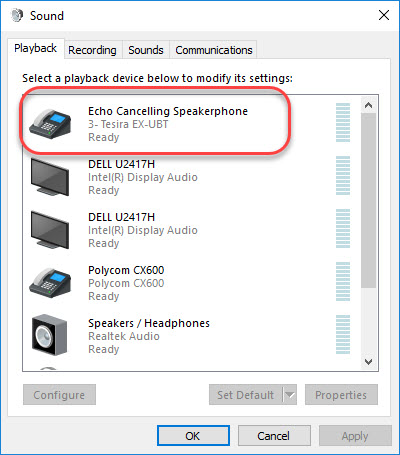
Setting Speaker Properties - When the TesiraFORTÉ presents itself as a line in Windows, this corresponds to the USB input block in the layout. Right-click the line icon and select Properties (both the TesiraFORTÉ and EX-UBT are shown below).

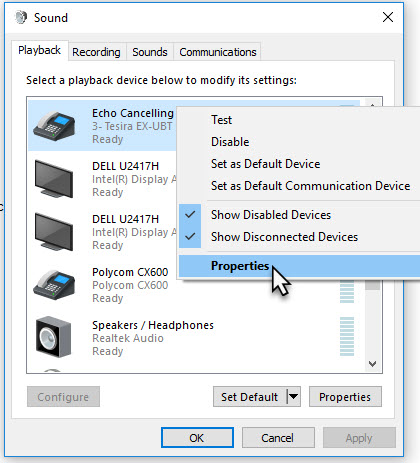
Within the properties window, select the Levels tab and note that the sound level may be set to a default value. Sometimes the sound from the PC is attenuated before arriving at the Tesira and it may not be audible. You may either use this control or USB Input block on the Tesira layout to adjust the levels of the incoming audio.
Multi-channel audio
The TesiraFORTÉ or EX-UBT / EX-USB is capable of processing 8 channels of audio, but Windows only handles two by default. Currently 3rd-party software is required to use more than two channels simultaneously. Several ASIO drivers exist on the market and it will be at a user's discretion to determine which one to use.
Using TesiraFORTÉ with EX-UBT / EX-USB or Using Mulitple EX-UBT / EX-USB devices ("ganged" devices)
In some scenarios involving 3rd-party audio software and other devices with high channel counts, it may be desired to host multiple EX-UBT / USB devices on one computer and 'gang' the EX-UBT / USBs into a single ASIO interface for multichannel recording. Additionally a TesiraFORTÉ may be combined with an EX-UBT to achieve high channel counts.
The Biamp USB driver must be installed in order to achieve these channel counts.
When Tesira devices are "ganged," the following channel counts may be achieved:
- TesiraFORTÉ and Tesira EX-UBT / USB: up to 16 channels (a maximum of 8 inputs or 8 outputs is available on the TesiraFORTÉ)
- Three Tesira EX-UBT / USBs: up to 24 channels
